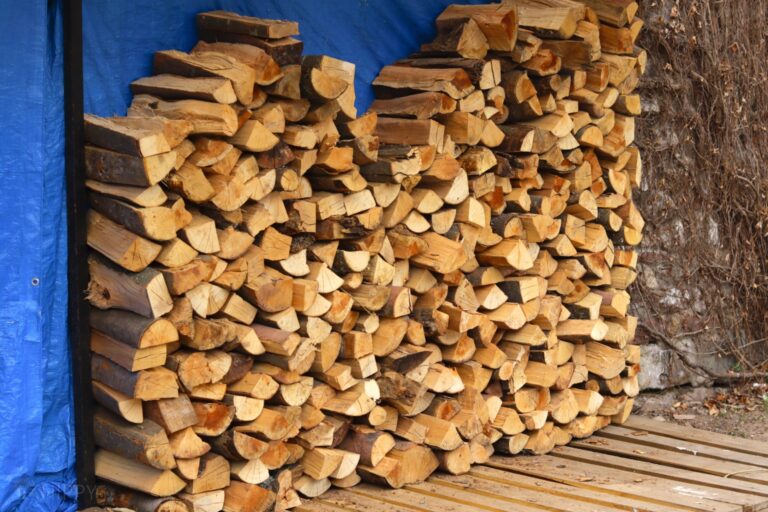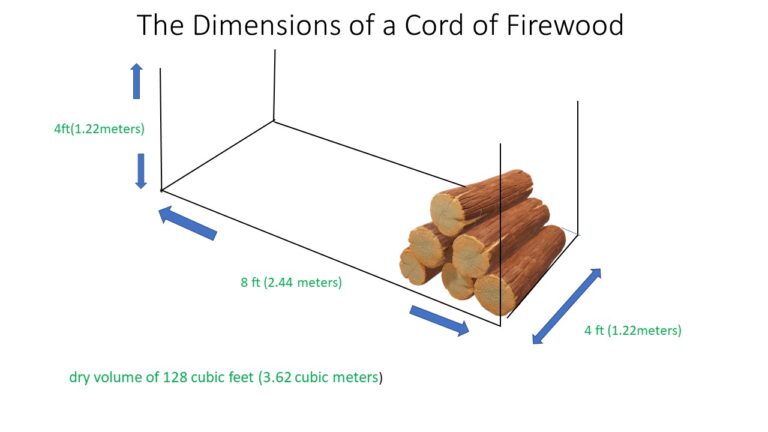Anyone who buys firewood regularly, whether for providing a permanent source of heat to a homestead or a cozy ambient fire in a traditional house, will be familiar with the term, “cord of firewood”.

However, if you are a first-time buyer you may want to know exactly how much wood will be included when buying a cord. So… how much firewood is in a cord?
A cord of wood is the amount that fits into 4 ft x 4 ft x 8 ft (1.22 meters x 1.22 meters x 2.44 meters) of space or, in other words a volume of 128 cubic feet (3.62 cubic meters). Thus, there are 128 cubic feet of firewood in a cord.

Many people think that cord is a subjective term, but it’s actually incredibly objective. It’s a standard of measurement.
A cord is a legal quantity and the term was first used at the beginning of the 17th century. At this time, a cord became the standard for firewood sold in Canada, the United States of America, and New Zealand.
Although the legislation acts differently in some states the aim of creating a measure of firewood is clear. This legislation enables anyone who buys firewood to be sure of exactly how much wood they will acquire when they buy a cord.
Will a Cord of Firewood Get Me Through the Winter Months?
This is an important consideration since having an adequate supply of firewood can become difficult as winter draws to an end.
No one wants to run out at a time when it is needed most. If we can establish exactly how much firewood we are getting, it’s possible to figure out if it is sufficient for our use.
It should be a simple task of measuring the quantity of wood that we are using daily.
Multiplying this figure by the number of days that we will be using firewood. You may want to consider adding a bit extra to be on the safe side, , which will give you a conservative estimate of what to expect.
Are You Getting a Good Value for Your Money?
Once you figure out how much wood is in a cord, you can compare prices from various suppliers. As with any product that you purchase, getting a good value for your money is important.
Although the term “cord” is a standardized unit of measurement, prices per cord vary to a great extent based on the state and region.
Anyone who is searching for a firewood supply could reasonably expect that it is a question of comparing the price of a cord from different suppliers. Comparing prices should ensure that you find the best price.
However, despite the legality of the measure, no two cords are quite exactly the same and therefore the amount of wood within them is different. Firewood is not like a box of chocolates that contains 6 dark and 6 milk varieties that all add up to a weight of 1lb.
How Much Firewood is in a Cord – in Real Terms?
We established that a cord of wood occupies a specific dry volume. However, that does not mean that the complete volume is full of wood. Firewood, whether intact or cut, is not a perfect square shape.
There will almost always be pockets of air between the wood and because these pockets can vary in size, despite the firewood processor’s best efforts, the size of the cord will obviously vary, too.
Although the dry volume measure of the cord is 128 cubic feet (3.62 cubic meters) if it were possible to measure only the wood that volume could be 80 cubic feet (2.27 cubic meters) and 100 cubic feet (2.83 cubic meters).
We might expect there to be 5,000 lbs. of firewood in a cord. However, the weight will vary according to the type of wood, its quality, how dry it is (which can impact whether it shrinks or not), and how well it is stacked. It is not unrealistic for it to weigh as little as 2,500 lbs.
If we look at the actual number of pieces of firewood in a cord, we again find a wide range of figures. A cord could contain anywhere between 400 and 1000 pieces of wood.
The more pockets of air that exist in the volume the lower the quantity of firewood.
The quantity of wood will depend on the shape of the wood and how it has been stacked. Wood, by nature, is cylindrical.
However, as a natural product, it is exceedingly rare for the shape to be a perfect cylinder. If not carefully stacked, there will be more air than necessary in the cord.
Which is More Important – Quantity or Quality?
Knowing exactly how much wood we are buying in a cord is important. However, it is just as important to understand the type and quality of firewood that it contains.
Not all wood is the same. That sounds like an obvious statement, however, what I mean is that different types of wood will burn to produce different levels of heat.
We are buying the wood to heat our house or possibly cook with, so we must achieve the best possible result.
Wood is classified into two types.
Hardwood
Woods such as oak, birch, ash, almond, and olive are hardwoods, and therefore burn better. This is because the fibers are denser and therefore, the wood will offer a longer-lasting, cleaner burn.
Clean burning wood is one that burns with little smoke.
Softwood
Larch, pine, and cedar are examples of softwood. This type of wood is often easier to light – however, it does burn quicker and often produces large quantities of smoke.
Softwood will normally produce a nice fragrance, however, the smoke produced makes this a betterr wood to burn outside rather than in the home.
Burning pine can also cause problems with smoke and creosote due to its high resin and sap content. The resin can deposit itself on the inside of a flue, making it inefficient to burn and also more likely to catch fire.
Combing the two types of wood, hardwood and softwood, in a fire is a sound idea. Softwood lights easier so it is possible to start the fire with it and then add hardwood when the fire is established.
Seasoned Wood is Always Best
The other factor that we should consider when looking at how much wood we are getting in our cord is whether the wood is seasoned or not.
Fresh cut wood or greenwood may have high levels of moisture, often as much as 50%.
Because of this, unseasoned wood can be exceedingly difficult to burn. Less heat will be produced by volume, making it a less efficient option (and therefore, worth less money).
Seasoned wood has been cut and left in a dry place for up to a year to allow the moisture level to drop to around 20%.
Creating seasoned wood is not an exact science, but some companies will dry wood in a kiln to ensure that the seasoning process is more controlled. Kiln-dried wood is a better product. However, it is often more expensive, too – you get what you pay for!
We saw earlier that a cord of wood could contain anywhere between 400 and 1000 pieces of wood.
Wood that has been seasoned or dried to reduce the moisture content will take up less space. Consequently, a cord that contains seasoned wood rather than fresh cut could contain 50 to 100 more pieces of wood.
Where the difference between hardwood, softwood, seasoned and unseasoned wood is appreciated is in the price. Quality seasoned wood will cost more.
However, we do need to be sure that we are not paying the higher value of seasoned wood for greenwood.
Conclusion
To ask how much firewood is in a cord is a particularly beneficial question. We all want to be sure that we are getting value for money.
We also want to know that we are buying sufficient to last the season. However, anyone who thinks that it is easy to answer the question of how much firewood in a cord is mistaken.
We have established that a cord s a dry volume that is defined as 128 cubic feet (3.62 cubic meters). The wood needs to be stacked into this volume to create a cord of firewood.
As we have realized that the problem arises when we realize that there are pockets of air in a cord that is caused by stacking irregularly shaped wood.
How efficiently the wood is stacked within this volume will affect how much wood is in the space. More open-air within the stack means less wood.
The problem answering the question is then compounded when we realize that not all wood is the same.
There is hardwood, softwood, greenwood, and seasoned wood. The differing types of wood will all have a different price and will have differing burning properties.
With differing burning properties different firewood will burn for various periods and produce varying quantities of heat.
We should also remember that we are buying a product, we need to be sure that we can trust the person that is selling the product. If we ask them how much firewood is in the cord, we want to be sure that the answer is correct.
It is important to view the cord of firewood to be able to assess how much is in the cord. We should also ask what the type of wood is and if concerned test the wood with a water meter. Cracks in the wood and the sound of the wood when struck can also indicate whether it is dry.
Armed with this information we can then compare cords of wood that contain similar types of wood. We can then be safe in asking how much firewood is in a cord whilst ensuring that we have covered all problems.

Three years ago, I bought an off-grid Cortijo in a small valley in the Andalucian mountains. Although, perhaps the lifestyle is in my genes as my grandfather and his four brothers were Homesteaders in Alberta Canada in the 1900s.
The mountains of Spain are a difficult place to grow many of the flowers that I was used to in the UK. However, veggies grow well year-round. Peppers, tomatoes, potatoes, lettuce, cucumber, melons, and chard all fare well in the Mediterranean climate. Almond trees provide me with a cash crop of around 1 ton while still retaining some to make almond milk and flour.
Meet the rest of the Homesteading Hippy team here.
